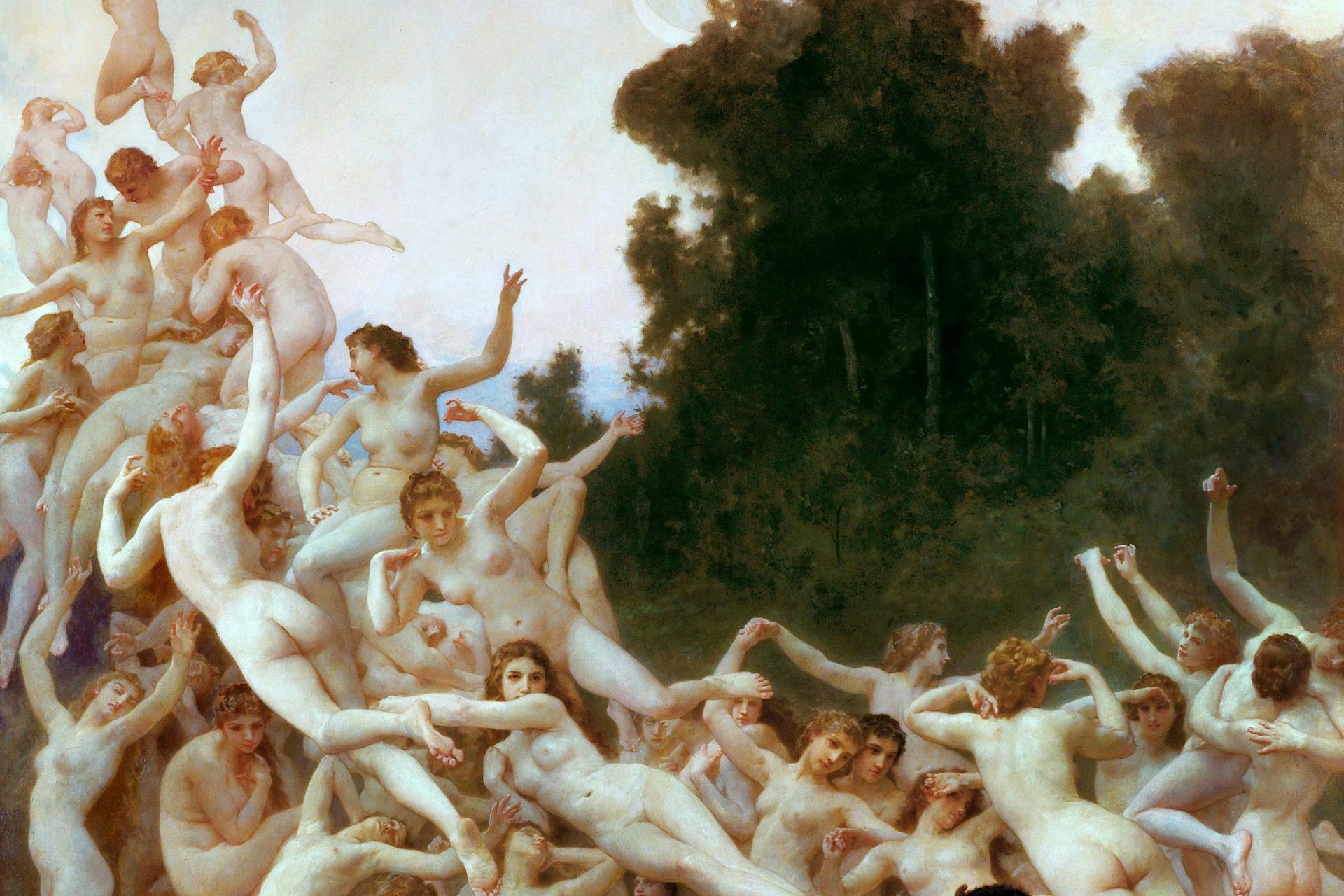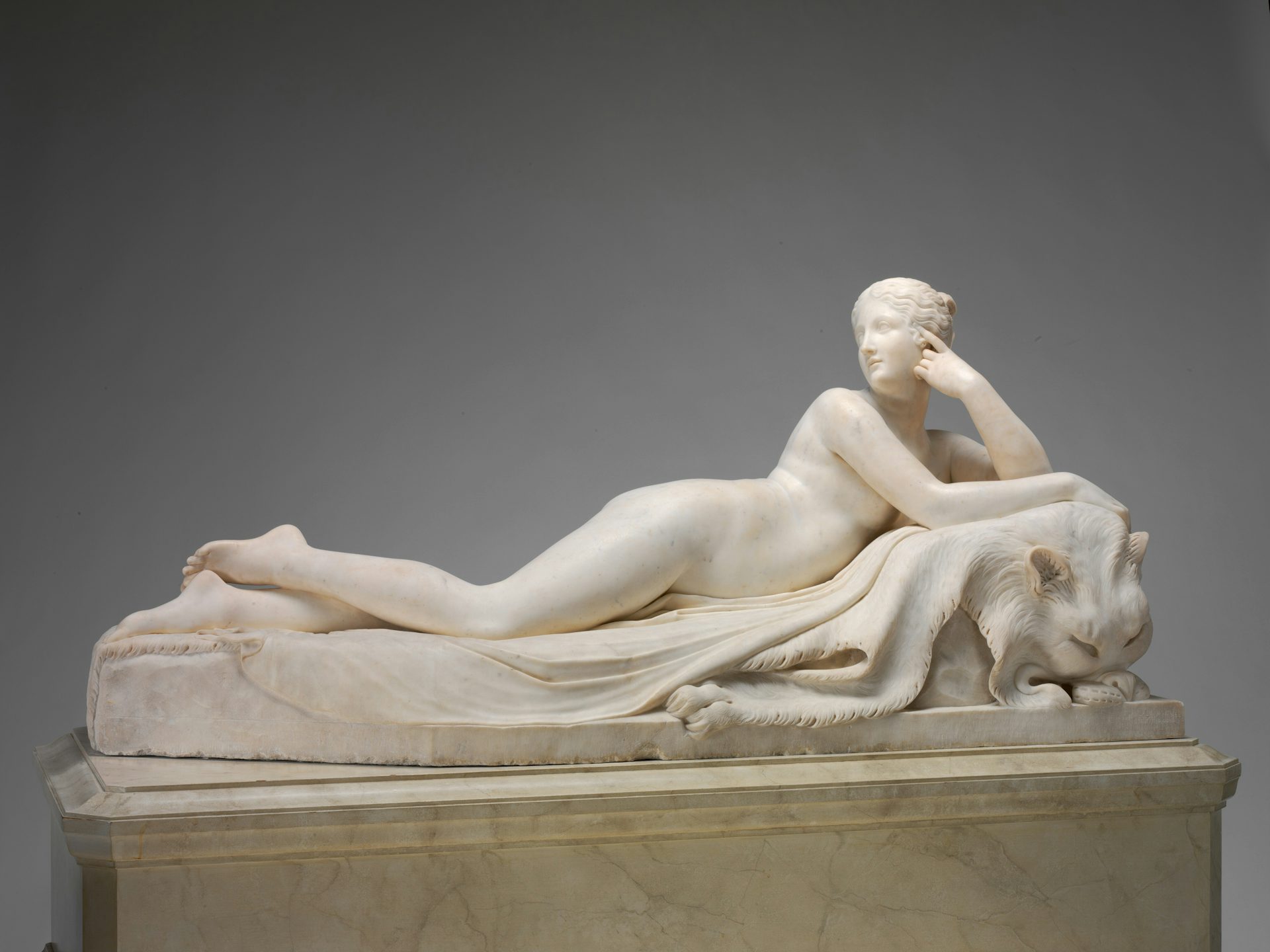Oreads

Les Oréades by William-Adolphe Bouguereau (1902)
Musée d'Orsay, ParisPublic DomainOverview
The Oreads—sometimes called Orestiades or Oressigonoi—were the mountain nymphs of Greek mythology. Like other nymphs, they were represented as beautiful young women. The Oreads lived in the mountains and were often seen in the company of other woodland gods like Pan or Artemis. They presided over herding, hunting, beekeeping, and other activities that took place in the mountains.
Some Oreads were named after the specific mountains they inhabited; examples include the Idaea of Mount Ida, the Cithaeronidae of Mount Cithaeron, and the Parnasidae of Mount Parnassus.
Etymology
The term “Oread” (Greek Ὀρειάς, translit. Oreias) comes from the Greek word ὄρος (translit. óros), meaning “mountain”—a word that is itself likely derived from the Indo-European root *h₃er-, meaning “rise.”[1]
Pronunciation
English
Greek
Oread, Oreads Ὀρειάς, Ὀρειάδες (translit. Oreias, Oreiades) Phonetic
IPA
[OHR-ee-ad, OHR-ee-adz] /ˈoʊr iˌæd, ˈoʊr iˌædz/
Alternate Names, Titles, and Epithets
The Oreads boasted numerous other titles and epithets that also reflected their connection with mountains; most of these contained some form of the element ὄρος (óros). Notable examples include ὀρεστιάδες (orestiádes), “of the mountains,”[2] ὀρεσσίγονοι (oressígonoi), “mountain-born,”[3] ὄρειαι (óreiae) or οὔρειαι (oúreiai), “of the mountains,”[4] ὀρεσκῷοι (oreskô(i)oi), “of the mountains,”[5] and so forth.
Other titles or epithets of the Oreads included ἀκραῖαι (akraîai), “of the heights,”[6] and πετραῖαι (petraîai), “of the rocks.”[7]
Attributes
The Oreads, like all nymphs, were envisioned as beautiful young female divinities. They inhabited and personified the mountains and were often imagined in the company of other nature gods, such as Pan or Artemis. They may have also presided over the various activities that took place in the mountains, including herding, hunting, beekeeping, tree cutting, and quarrying.[8] They were sometimes said to possess oracular powers.

Naiad by Antonio Canova (1815/1817–1820/1823)
National Gallery of Art (US)Public DomainThe Oreads represented one of the main categories of nymphs, alongside the Naiads (water nymphs associated with springs).[9] However, “Oread” was a very loose classification within the Greek taxonomy of nymphs. It could include any number of subcategories, especially other land nymphs, such as tree nymphs (Dryads, Hamadryads) and grove nymphs (Alseids).
The Oreads sometimes even overlapped with the spring or water nymphs, who usually comprised a separate category. For example, a nymph who lived in the mountains could be called an Oread, but she could also be a Naiad if she spent her days in a mountain spring, or a Hamadryad if her life was linked to a specific tree on the mountain.
Some mountain nymphs could be further categorized according to their precise location. We thus hear of various groups of nymphs whose titles are derived from the mountains they inhabited. Some examples include:
Caucaseae (nymphs of the Caucasus Mountains)[10]
Cithaeronides or Sphragitides (nymphs of Mount Cithaeron in Boeotia)[11]
Coryciae (nymphs of the Corycian Cave on Mount Parnassus)[12]
Dictaeae (nymphs of Mount Dicte in Crete)[13]
Erymanthiades (nymphs of Mount Erymanthus in Achaea)[14]
Heliconides (nymphs of Mount Helicon in Boeotia)[15]
Idaeae (nymphs of Mount Ida)[16]
Maenaliae (nymphs of Mount Maenalus in Arcadia)[17]
Parnasides (nymphs of Mount Parnassus near Delphi)[18]
Peliades (nymphs of Mount Pelion in Thessaly)[19]
Ptoides (nymphs of Mount Ptous in Boeotia)[20]
Family
The Oreads’ origins are obscure. A fragment attributed to Hesiod lists them among the descendants of Dorus, one of the earliest inhabitants of mythical Greece, and calls them the sisters of the satyrs and Curetes.[21] Other early poets—Homer, for example—appear to have regarded the mountain nymphs (like all nymphs) as daughters of Zeus.[22]
In most sources, however, the Oreads, like other nymphs, are said to be independently descended from various different parents.[23]
Mythology
Given that Greece is a rocky country, it is unsurprising that many myths are set in the rolling mountains and foothills. Such myths often involve the Oreads.
Some stories tell of how the mountain nymphs cultivated the woodlands and the mountains around them. The earliest known reference to mountain nymphs, from Homer’s Iliad, describes how these nymphs (here said to be daughters of Zeus) planted elm trees around the tomb of King Eetion of Cilician Thebes after he was slain by Achilles.[24]
Mountain nymphs were often companions of the gods. The nymphs of Mount Ida in Phrygia, for example, belonged to the entourage of Cybele, an important mother goddess who roamed the mountains in a chariot drawn by lions.[25] Artemis, the goddess of the wild, was sometimes said to hunt with the nymphs of the Caucasus Mountains.[26]

Diana and Her Nymphs after Their Hunt by Jan Brueghel the Younger (ca. 1630–1639)
The Walters Art MuseumPublic DomainMountain nymphs, like other nymphs, were also frequently the lovers of famous gods and mortals. Unfortunately, these love affairs did not always end happily.
One well-known myth tells of how Echo, a nymph who lived in the mountains of Boeotia, fell in love with the handsome mortal Narcissus. But Echo could not speak independently and was only able to repeat the words that others had already spoken to her (a punishment for offending Hera, the queen of the gods).
Echo’s strange way of speaking repulsed the vain Narcissus, and he spurned the nymph. Echo was devastated and slowly wasted away until she was nothing but a disembodied voice repeating the words of passersby—in short, nothing but an “echo.”[27]

Echo and Narcissus by John William Waterhouse (1903)
Walker Art Gallery, LiverpoolPublic DomainSome mountain nymphs were known for giving their names to towns, cities, or features of the landscape. For instance, the Nomian Mountains in Arcadia may have derived their name from a nymph.[28] However, other mountain nymphs, such as the Cyllene and Idaea, seem to have been named after important mountains, rather than vice versa.[29]
Worship
The Oreads, like other nymphs, were worshipped in many parts of Greece, at sanctuaries known as nymphaea.
The Coryciae, for instance, had an impressive sanctuary in their cave near Delphi (the famous Corycian Cave). Numerous offerings, such as figurines, knucklebones, and small vessels called aryballoi, have been discovered at this site.[30]
The nymphs of Mount Cithaeron in Boeotia, called the Cithaeronides or Sphragitides, also had an important sanctuary. Here, the local mountain nymphs were at one point believed to deliver prophecies.[31]